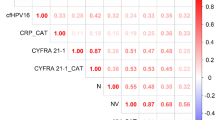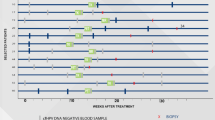Abstract
Purpose
Although HPV-positive and negative oropharyngeal cancers are two distinct diseases, Post-Therapeutic Surveillance (PTS) modalities are similar. Adjusting PTS strategies to HPV status will represent a massive practice change that raises the issue of its acceptability, by both physicians and patients.
Methods
Two distinct surveys were designed and submitted, respectively, to HPV-positive patients and physicians (surgeons, radiation and medical oncologists) involved in head and neck cancer treatment.
Results
133 patients and 90 physicians have participated to the study. Most patients were reluctant to embrace new PTS options (remote consultations, nurse consultations and smart phone applications). However, 84% of patients would be favorable to use HPV Circulating DNA (HPV Ct DNA) measurement to guide surveillance modalities. 57% of physicians acknowledged that our current PTS strategy is improvable and most of them would accept the use of new monitoring options from the third year of follow-up. 87% of physicians would be interested to participate to a trial comparing the current PTS strategy to a new approach, where monitoring modalities (number of visits, imaging prescription) would depend on HPV Ct DNA level.
Conclusions
Patients and physicians are aware that PTS modalities should depend on HPV status. Their adhesion is a prerequisite to any potential changes. Strategies based on HPV Ct DNA measurement should be assessed within a randomized clinical trial.

Similar content being viewed by others
References
Ang KK, Harris J, Wheeler R et al (2010) Human papillomavirus and survival of patients with oropharyngeal cancer. N Engl J Med 363:24–35
Fakhry C, Westra WH, Li S. Improved survival of patients with human papillomavirus-positive head and neck squamous cell carcinoma
www.sforl.org (French PTS recommendations)
www.nccn.org (American PTS recommendations)
Lee JY, Garcia-Murillas I, Cutts RJ et al (2017) Predicting response to radical (chemo)radiotherapy with circulating HPV DNA in locally advanced head and neck squamous carcinoma. Br J Cancer 117(6):876–883. https://doi.org/10.1038/bjc.2017.258
Chera BS, Kumar S, Beaty BT et al (2019) Rapid Clearance Profile of Plasma Circulating Tumor HPV Type 16 DNA during Chemoradiotherapy Correlates with Disease Control in HPV-Associated Oropharyngeal Cancer. Clin Cancer Res 25(15):4682–4690
Routman D, Chera BS, Jethwa K et al (2019) Detectable HPV ctDNA in Post-Operative oropharyngeal squamous cell carcinoma is associated with progression. Int J Radiat Oncol Biol Phys 105(3):682–683
Chera BS, Kumar S, Shen C et al (2020) Plasma circulating tumor HPV DNA for the surveillance of cancer recurrence in HPV-associated oropharyngeal cancer. J Clin Oncol 38(10):1050–1058
- Reder H, Taferner VF, Wittekindt C, et al. Plasma cell-free human papillomavirus oncogene E6- and E7-DNA predicts outcome in oropharyngeal squamous cell carcinoma [published online ahead of print, 2020 Aug 18]. J Mol Diagn. 2020;S1525–1578(20)30429–3.
Ilmarinen T, Keski-Säntti H, Markkanen-Leppänen M et al (2019) De-escalation of post-treatment surveillance in oropharyngeal cancer. Head Neck 41(5):1457–1462
Pagh A, Vedtofte T, Lynggaard CD et al (2013) The value of routine follow-up after treatment for head and neck cancer. A national survey from DAHANCA. Acta Oncol 52(2):277–284. https://doi.org/10.3109/0284186X.2012.741324
Schwartz DL, Barker J Jr, Chansky K et al (2003) Postradiotherapy surveillance practice for head and neck squamous cell carcinoma–too much for too little? Head Neck 25(12):990–999
Malik A, Nair S, Sonawane K et al (2020) Outcomes of a telephone-based questionnaire for follow-up of patients who have completed curative-intent treatment for oral cancers. JAMA Otolaryngol Head Neck Surg 146(12):1102–1108. https://doi.org/10.1001/jamaoto.2020.2404
Gharzai LA, Burger N, Li P, Jaworski EM et al (2021) Patient burden with current surveillance paradigm and factors associated with interest in altered surveillance for early stage HPV-related oropharyngeal cancer. Oncologist 26(8):676–684. https://doi.org/10.1002/onco.13784
Frakes JM, Naghavi AO, Demetriou SK et al (2016) Determining optimal follow-up in the management of human papillomavirus-positive oropharyngeal cancer. Cancer 122(4):634–641
Masroor F, Corpman D, Carpenter DM, Ritterman Weintraub M, Cheung KHN, Wang KH (2019) Association of NCCN-recommended posttreatment surveillance with outcomes in patients with HPV-associated oropharyngeal squamous cell carcinoma. JAMA Otolaryngol Head Neck Surg 145(10):903–908
Chen MM, Mott NM, Miller J et al (2022) Clinician attitudes and beliefs about deintensifying head and neck cancer surveillance. JAMA Otolaryngol Head Neck Surg 148(1):43–51. https://doi.org/10.1001/jamaoto.2021.2824
Funding
No funding.
Author information
Authors and Affiliations
Corresponding author
Ethics declarations
Conflict of interest
The authors have nothing to disclose.
Additional information
Publisher's Note
Springer Nature remains neutral with regard to jurisdictional claims in published maps and institutional affiliations.
Supplementary Information
Below is the link to the electronic supplementary material.
Rights and permissions
Springer Nature or its licensor (e.g. a society or other partner) holds exclusive rights to this article under a publishing agreement with the author(s) or other rightsholder(s); author self-archiving of the accepted manuscript version of this article is solely governed by the terms of such publishing agreement and applicable law.
About this article
Cite this article
Mirghani, H., Troux, C., Leroy, C. et al. Post-therapeutic surveillance of HPV-driven oropharyngeal cancers: are we ready to change our practices?. Eur Arch Otorhinolaryngol 280, 3811–3820 (2023). https://doi.org/10.1007/s00405-023-07952-8
Received:
Accepted:
Published:
Issue Date:
DOI: https://doi.org/10.1007/s00405-023-07952-8




